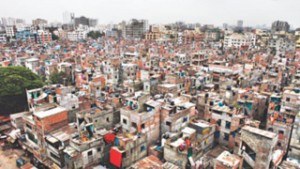Friday, April 19, 2024
News and Views from the Global South
The New Urban Agenda: What Our Cities Can Be
- The future is urban and nowhere is that more true than in Bangladesh. If current rates of urbanisation continue, the country’s urban population will double by 2035. Around the Bay of Bengal, a mega city would join Dhaka to Chittagong, creating one of the world’s largest conglomerations. Whether that process produces a congested toxic unlivable mess of concrete and steel, or whether it becomes a thriving, connected, wonderful city to live in, is almost entirely down to the political and policy choices we make.
The new agenda is intended to reinvigorate the global commitment to sustainable urbanisation. The conference is expected to result in a concise, focused, forward-looking and action-oriented outcome document on making cities and human settlements equitable, prosperous, sustainable, just, equal and safe until 2030. By the middle of the century, a majority of the world’s citizens —four out of five people — could be living in towns or cities. Indeed, in the time since the Habitat Agenda was adopted, the world has become majority urban, lending extra urgency to the New Urban Agenda.
Habitat III is one of the first major global conferences to be held after the adoption of two key agreements, last year. Agenda 2030, a new development plan for the world; and a new Climate Change agreement adopted in Paris. It offers a unique opportunity to discuss the important challenge of how cities, towns and villages are planned and managed in a sustainable manner, to meet the new global agenda and climate change goals.
The New Urban Agenda, agreed upon at Habitat III in Quito, will guide the efforts around urbanisation of a wide range of actors — nation states, city and regional leaders, international development funders, UN programmes and civil society — for the next 20 years. Inevitably, this agenda will also lay the groundwork for policies and approaches that will have long lasting impact.
HABITAT I and II
Forty years later, after both Habitat I and II, there is wide consensus that towns’ and cities’ structure, form, and functionality need to change as societies change. Especially, slums and related informal settlements that have become a spontaneous form of urbanisation, consisting of a series of survival strategies by the urban poor, most borne out of poverty and exclusion.
Habitat III represents an opportunity to make concrete the ideals of Habitat II in designing policies, planning urban spaces for all, and providing affordable urban services and utilities through adopting a ‘New Urban Agenda’ this October.
Towards the New Urban Agenda
The core issues of the Habitat II Agenda — adequate housing and sustainable human settlements — remain on the table, as the number of people worldwide living in urban slums continues to grow. There is also an increasing recognition that cities have morphed into mega-regions, urban corridors and city-regions whose economic, social and political geographies defy traditional conceptions of the “city”.
Impact of the agenda
The Agenda will seek to create a mutually reinforcing relationship between urbanisation and development. Several core ideas form the ideological underpinnings of the New Urban Agenda. Democratic development and respect for human rights feature prominently in the draft agreements, as does the relationship between the environment and urbanisation.
The new agenda also places importance on establishing a global monitoring mechanism to track progress on meeting commitments. As an “agenda”, it will provide guidance to nation states, city and regional authorities, civil society, foundations, NGOs, academic researchers and UN agencies. However, this guidance is not binding. This arrangement is different from, for example, the December 2015 climate negotiations in Paris, which resulted in a legally binding agreement.
Let’s take a practical example. The new urban agenda calls for mass transit systems and to cut back our dependence on vehicles. In recent years in Dhaka, our response to traffic congestion has been to build flyovers. This has been compared to an overweight person addressing the need to lose weight by loosening their belt. You feel better at first, but it doesn’t last. The underlying issues are not addressed. The government recently broke ground on metro rail link between Uttara and the airport. With policy choices like this, we can move Dhaka to the fore of the New Urban Agenda.
The New Urban Agenda and Bangladesh
A broad range of actors in Bangladesh were involved in contributing to developing the New Urban Agenda. The Government of Bangladesh, through the Ministry of Housing and Public Works, is engaged in both the Habitat III conference and related academic discussions through various national and international forums.
It is estimated that 60 percent of Bangladesh’s GDP is produced in urban areas. Having laid out an urban vision in the 7th Five-year Plan as “compact, networked, resilient, competitive, and inclusive and smart,” Bangladesh still has considerable work ahead to meet international goals set by the New Urban Agenda. Certainly, in Bangladesh the stakes are high, since it is the third most urbanised nation in South Asia.
The ‘new urban agenda’ will clearly influence policymakers as they consider cities, urbanisation and sustainable development, and set priorities at the national levels. With the global perspectives on managing urbanisation for making cities and human settlements equitable, prosperous, sustainable, just, equal and safe, Bangladesh can finalise the long awaited national urban sector policy. And it can begin drafting a ‘New Urban Agenda’ to tackle the country’s rapid urbanisation in order to maximise the benefits of urbanisation for the people of Bangladesh.
The writers are Acting Country Director of UNDP Bangladesh and Urban Programme Specialist of UNDP Bangladesh.
This story was originally published by The Daily Star, Bangladesh

 Print
Print




